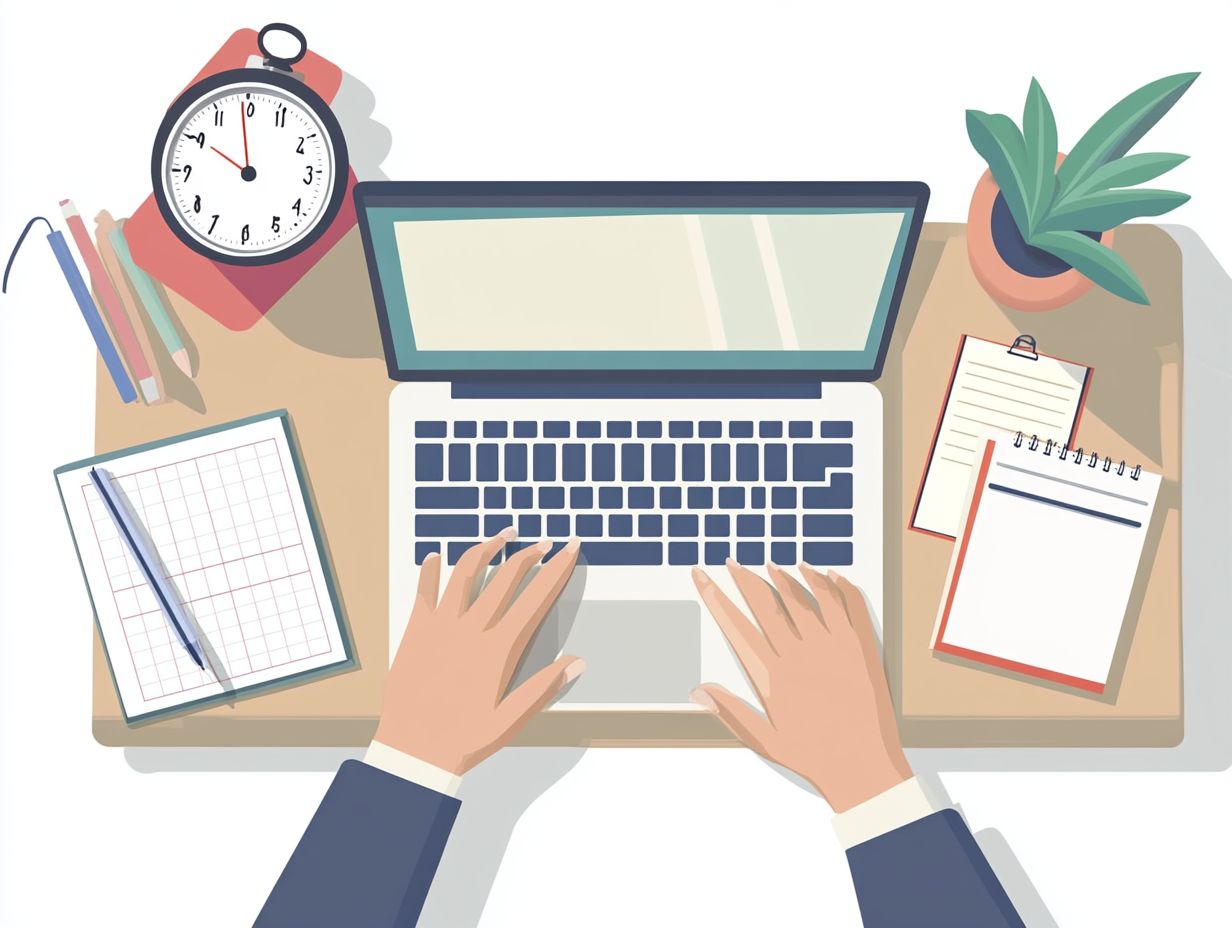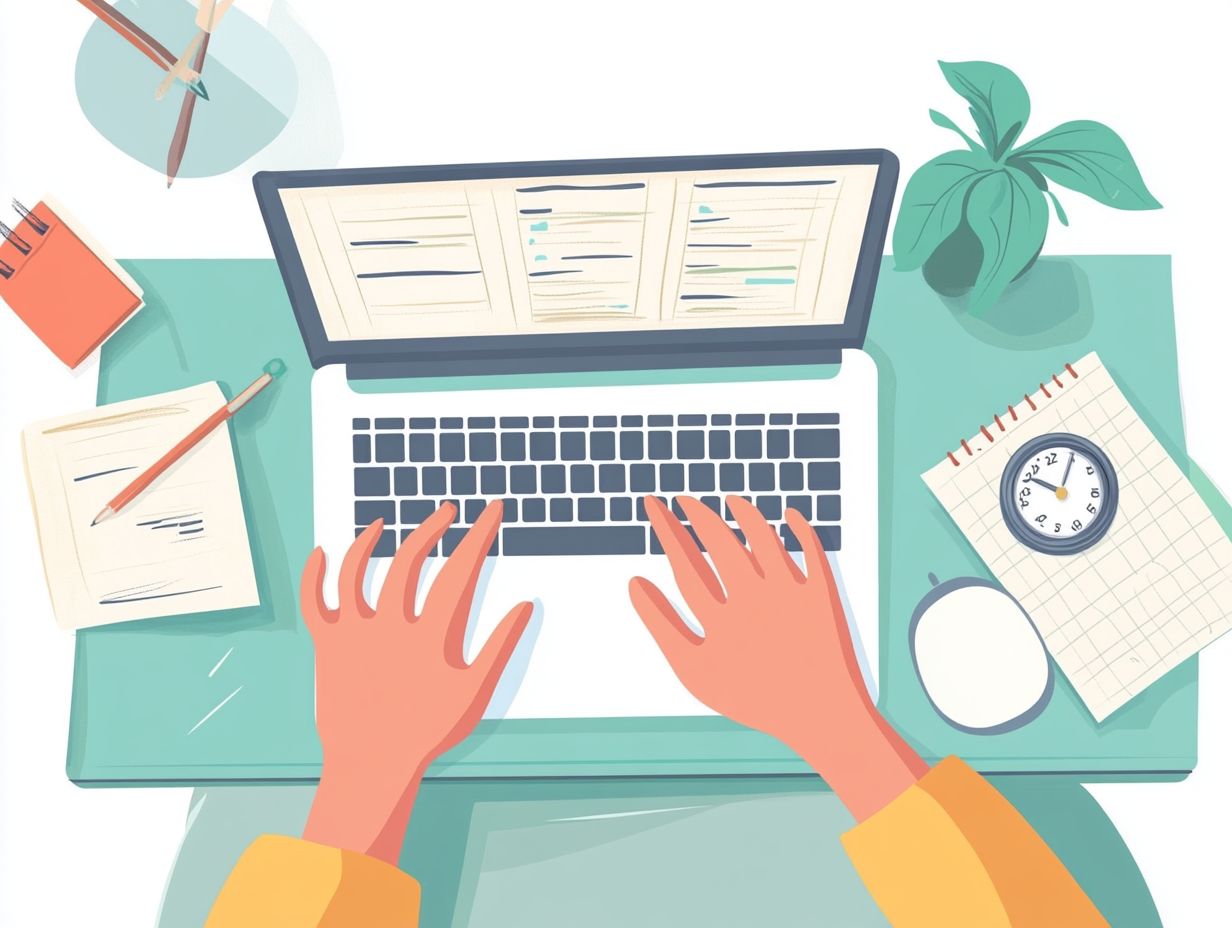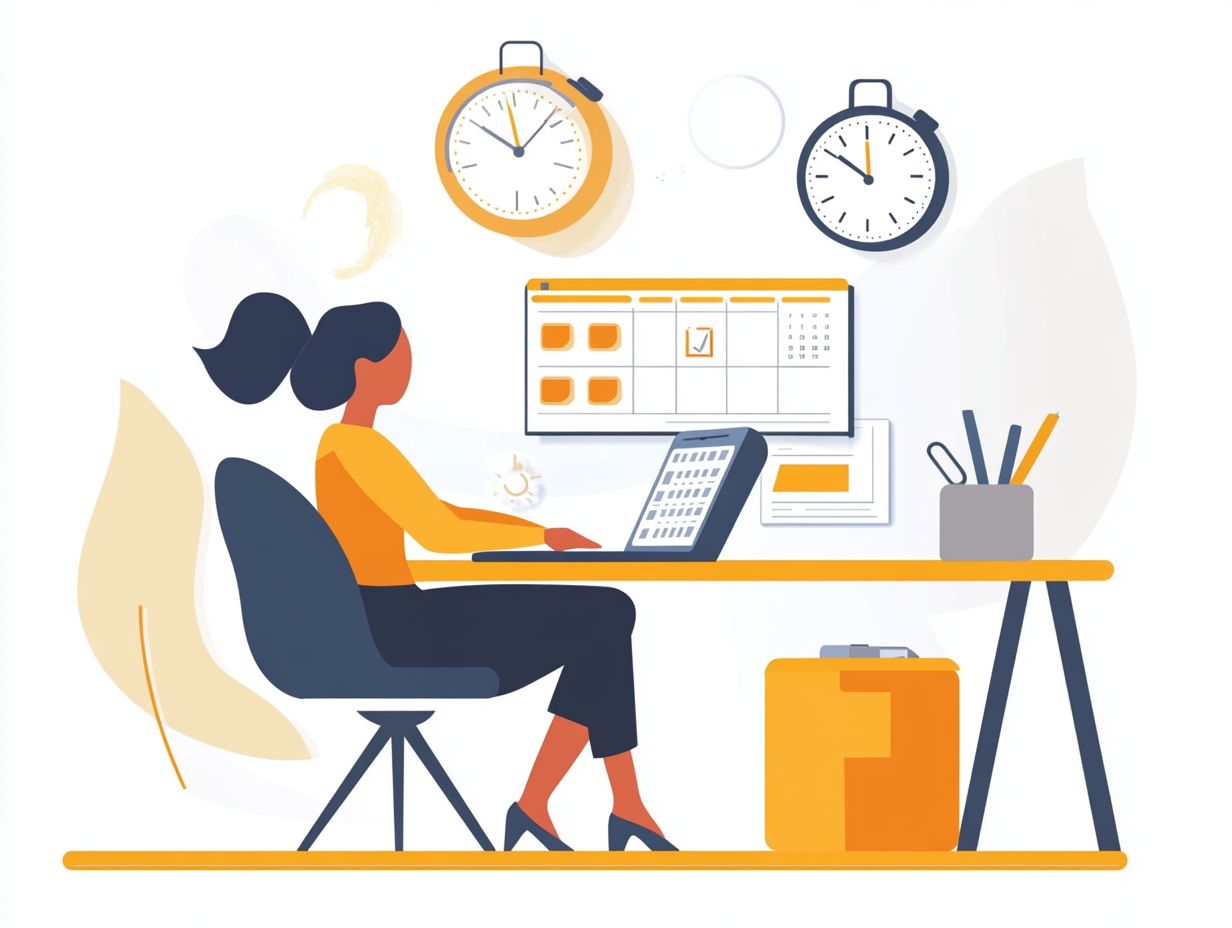Mastering the art of time management can significantly impact whether one experiences a productive day or a chaotic one, influencing one s work-life balance and overall efficiency. Read on to discover how to get more work done in less time.
Understanding productivity and efficiency is merely the beginning. By identifying common distractions, procrastination triggers, and psychological factors, individuals can start to reclaim their valuable time and enhance their personal productivity.
This article delves into effective strategies for prioritization, explores the benefits of time blocking, and introduces various tools both digital and analog that can enhance your approach. It offers insights into automation and task delegation to streamline your workflow.
Creating a conducive workspace and adopting healthy habits will play a crucial role in boosting productivity and minimizing downtime.
We will discuss methods to measure and track progress, ensuring that each minute spent is a step closer to achieving your goals, emphasizing the importance of performance indicators and continuous improvement.
Whether you are a student, a professional, or simply someone looking to improve time management skills, this guide offers actionable insights to help you work smarter, not harder, by focusing on techniques for efficiency and cognitive load management.
Understanding How to Get More Work Done in Less Time
Understanding time management is crucial for enhancing productivity and efficiency in both personal and professional realms. Effective time management enables individuals to prioritize tasks, streamline workflows, and maintain a balanced workload, facilitating better decision-making and project management.
By mastering techniques like delegation and automation, one can improve organization and planning skills, which leads to better work habits, stress management, and fosters a successful, results-oriented environment.
Moreover, grasping the principles of goal setting and performance tracking, using tools like productivity apps, equips you to meet deadlines and achieve optimal results, making time management an essential skill for both professional growth and personal development.
Defining Productivity and Efficiency
Productivity refers to the rate at which tasks are completed and goals are achieved, while efficiency focuses on accomplishing those tasks with minimal waste of resources, including time and energy. Understanding these concepts is crucial for anyone aiming for success in their personal or professional lives.
By measuring productivity through various metrics, such as output per hour or task completion rates, individuals and organizations can gain valuable insights into their performance levels. Efficiency can be evaluated by examining resource utilization, taking into account both human and material factors.
The relationship between productivity and efficiency plays a significant role in overall outcomes. Individuals or teams that are highly productive and also practice efficient methods tend to not only meet their targets consistently but do so in a way that conserves valuable resources. Therefore, emphasizing both productivity and efficiency is essential for achieving long-term success and sustaining growth.
Identifying Time Wasters
Identifying time wasters is essential for maintaining focus and enhancing overall efficiency. Distractions can severely hinder productivity and often lead to procrastination, so being aware of them is key to staying on track.
Common Distractions and Procrastination Triggers
Common distractions and triggers for procrastination can greatly hinder your ability to stay focused and productive, making it essential to identify and address them in order to improve mental clarity and overall engagement.
Many individuals often find themselves sidetracked by the constant notifications from their phones, the tempting draw of social media, and a cluttered environment that fosters chaos. These distractions not only interrupt the work process but also create a cycle of avoidance that negatively affects efficiency.
To counter these challenges, it is important to adopt effective focus techniques, such as the Pomodoro Technique, which organizes work sessions into intervals followed by short breaks. Additionally, tips for getting work done fast include establishing a dedicated workspace, disabling notifications, and designating specific times for checking social media, all of which can significantly improve concentration and self-discipline.
By implementing these strategies, one can effectively overcome procrastination and enhance overall productivity, leading to better outcomes and time efficiency.
Effective Time Management Strategies
Effective time management strategies play a crucial role in enhancing productivity and achieving a healthy balance in one s workload, improving both workflow and energy levels.
By implementing these strategies, individuals can prioritize their tasks more effectively, manage their schedules with greater ease, and enhance their planning and organizational skills.
Prioritization Techniques
Prioritization techniques play a crucial role in effective task management, allowing individuals to concentrate on the most critical items and make informed decisions regarding their workload and commitments.
Implementing strategies such as the Eisenhower Matrix, which differentiates between urgent and important tasks, can greatly streamline daily routines. This approach helps individuals determine what requires immediate attention and what can be scheduled for later.
Similarly, the ABC prioritization method offers a tiered approach to tasks, aiding in the identification of high-priority activities that can maximize productivity. Both methods encourage a thoughtful examination of each task’s contribution to broader goals, ultimately saving time and reducing stress.
By adopting these techniques, individuals not only enhance their decision-making capabilities but also cultivate a proactive attitude toward their daily responsibilities.
Time Blocking and Scheduling
Time blocking and scheduling are effective techniques that allow individuals to dedicate specific periods to various tasks, thereby enhancing productivity and optimizing workflow.
By organizing their days around these methods, one can significantly minimize distractions and improve concentration on important assignments. To implement these techniques successfully in daily routines, it is crucial to start by identifying priorities and breaking larger projects into smaller, manageable tasks.
Establishing clear boundaries for work intervals can help maintain momentum while also providing opportunities for breaks to recharge.
Utilizing digital calendar tools or planners can aid in visualizing time commitments, making it easier to adhere to planned schedules. Maintaining discipline may require setting reminders and holding oneself accountable, perhaps through regular check-ins or progress tracking, and seeking feedback for continuous improvement.
These strategies are all aimed at fostering motivation and ensuring that deadlines are met without the experience of feeling overwhelmed, leading to better performance and time-saving benefits. For additional insights, check out these tips for small business owners to get more done.
Tools and Resources for Time Management
Utilizing the appropriate tools and resources for time management can greatly enhance productivity. These tools help streamline tasks, improve performance tracking, and foster better workflow optimization, making it easier to stay organized and efficient.
Digital and Analog Options
Both digital and analog tools present unique advantages for time management, catering to various preferences and styles that enhance productivity and organization, supporting a wide range of techniques and methods.
Digital solutions, such as apps and software, come equipped with dynamic features like reminders, device synchronization, and real-time updates, making them particularly beneficial for those who thrive on technology. Conversely, analog options, including planners and checklists, offer a tactile experience that can enhance focus and retention of tasks, especially for individuals who appreciate the simplicity and elegance of handwriting. Both options can aid in effective time tracking and personal productivity.
Each approach provides distinct pathways to structure daily activities and personal projects, appealing to different learning styles and habits. Ultimately, the choice between these tools often depends on personal preference and how individuals envision their organizational systems.
Creating a Productive Work Environment
Creating a productive work environment entails optimizing both physical and mental spaces to improve focus, organization, and overall work habits. This approach leads to more effective energy management and enhances overall productivity and workflow optimization.
Optimizing Your Workspace
Optimizing your workspace is essential for minimizing distractions and enhancing your overall work environment, which in turn can lead to improved productivity and focus.
To achieve this, you might consider implementing specific strategies, such as decluttering your desk by removing unnecessary items that could divert your attention. Keeping frequently used tools within arm’s reach not only enhances your efficiency but also contributes to a more streamlined workflow and better engagement. For additional insights, check out these tips on how to get stuff done efficiently.
Effective organization is crucial; utilizing labelled folders and storage solutions can help categorize your documents and supplies, making it easier to locate what you need when you need it, thus optimizing your cognitive load and efficiency.
Additionally, do not overlook the importance of ergonomics. Investing in a chair with good lumbar support and positioning your computer screen at eye level can significantly reduce strain and fatigue, contributing to overall work environment optimization.
All of these elements work together to create a workspace that fosters concentration and satisfaction, ultimately boosting your productivity and effectiveness.
Healthy Habits for Increased Productivity
Incorporating healthy habits into your daily routine can greatly enhance productivity, improve energy management, and encourage a better work-life balance. These habits also support better mental clarity and stress management.
Taking regular breaks throughout the day allows individuals to recharge their mental faculties and avoid burnout, enabling them to return to their tasks with renewed focus. Engaging in physical activity, whether it s a brisk walk or a short workout, not only releases endorphins that elevate mood but also boost cognitive function.
Prioritizing self-care practices, such as meditation or journaling, can foster emotional resilience. When these habits are seamlessly integrated into one’s lifestyle, they cultivate an environment that supports both personal and professional growth, ultimately leading to a more fulfilling and productive life.
Measuring and Tracking Progress
Measuring and tracking progress is essential for evaluating performance and ensuring that your goal-setting aligns with your desired outcomes. This process provides valuable feedback that supports continuous improvement.
Setting Goals and Evaluating Results
Setting clear goals and evaluating results are essential components of effective time management, allowing individuals to measure their success through specific performance metrics.
By establishing specific and measurable objectives, individuals can direct their efforts more productively while also maintaining focus on what truly matters. This level of clarity facilitates better task prioritization, ultimately enhancing overall performance.
Regularly assessing progress against these goals makes it easier to pinpoint areas that may need improvement. This process of evaluating results promotes a growth mindset, encouraging individuals to adjust their strategies as necessary, ensuring that their efforts align with both short-term achievements and long-term aspirations.
In the end, this disciplined approach to goal setting and evaluation can pave the way for sustained success and personal fulfilment.
Frequently Asked Questions
What are some tips for getting more work done in less time?
Some tips for getting more work done in less time include setting specific goals, prioritizing tasks, and using time management techniques such as the Pomodoro method.
How can I improve my productivity?
To improve productivity and get more work done in less time, try eliminating distractions, taking regular breaks, and delegating tasks when possible.
Is multitasking an effective way to get more work done in less time?
No, multitasking can actually decrease productivity and quality of work. It’s better to focus on one task at a time and give it your full attention.
What is the importance of planning when it comes to getting more work done in less time?
Planning is crucial for maximizing productivity and getting more work done in less time. It allows you to prioritize tasks and allocate time accordingly.
How can I stay motivated and avoid burnout when trying to get more work done in less time?
To stay motivated and avoid burnout, try setting realistic goals, rewarding yourself for completing tasks, and taking breaks throughout the day to rest and recharge.
Are there any tools or apps that can help me get more work done in less time?
Yes, there are many productivity tools and apps available that can help you stay organized, manage your time, and increase efficiency. Some popular options include Trello, Evernote, and Asana.










